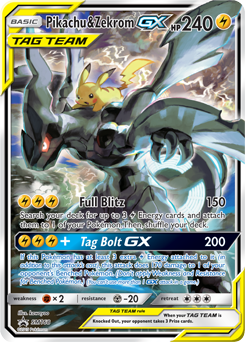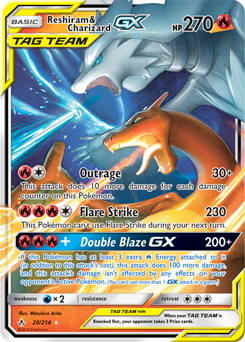Out of the Limelight(ning) — Unusual Decks From EUIC

The European International Championship has concluded, and even though the SUM–TEU format is also nearing its end, it’s still worth looking at the results. There are still a few major events left in the current format, including, for Europeans such as me, a Regional Championship in Bristol, UK; but more importantly, the lessons we learn from the current format can also apply to the next format, after Unbroken Bonds‘s release. This format is still largely unknown to the West and I have no doubt that it holds many surprises for us, but we can still begin to explore it. (As a disclaimer, I haven’t played any games in this format yet, since I was focusing on the EUIC and, at the time of writing, the new set isn’t available on TCGO yet. I have been looking at Japanese results and lists for ideas, though, so I’m not going in totally blind.)
To the surprise of no one, Lightning decks dominated the EUIC. Pikachu and Zekrom-GX cemented its status as the BDIF by being half of the Top 8 by itself, and Zapdos decks — mainly, though not exclusively, Zapdos / Ultra Beasts — also performed well. Combined, these two archetypes made up more than 60% of the day 2 metagame. The third most successful archetype, distantly behind PikaRom and Zapdos, was Zoroark-GX variants. It comprised 11% of the Day 2 metagame, but had good performances in Day 2: out of ten Zoroark-GX decks, three made Top 8, and three more made Top 16. This is not surprising since Zoroark-GX / Lycanroc-GX is favored against both Zapdos and PikaRom, so Zoroark-GX players tended to have a smooth Day 2, compared to Day 1 when they were more likely to hit an unfavorable matchup such as Blacephalon-GX / Naganadel. Apart from these three archetypes, no deck had a strong performance. Malamar had a few representatives in Day 2, but once again struggled against the sea of Zapdos. Blacephalon-GX had a bad time, and stall players also struggled against the speed of PikaRom and the techs of other decks.
However, that doesn’t mean there were no surprises in the tournament. Several unusual decks made appearances in Day 2, and in this article I’ll focus on them, for two reasons. The first reason is that if I talked once again about Malamar or Zoroark-GX / Lycanroc-GX, when not much about these decks has changed, you’d probably be — rightly! — bored. The second reason is that I want to talk about these decks’ chances, not only in the current format, but also in the next one, and it will take more time to understand a popular deck’s role in the format than an unpopular one. For example, Pikachu & Zekrom-GX will probably still be a major deck after Unbroken Bonds is released, so people will still tech for it. Finding the right Pikachu & Zekrom-GX list will take time and, if I were to offer you one, there’s a good chance that it would be far from optimal since, again, I haven’t had time to test in the new format. However, for a less popular decks, say Naganadel / Quagsire, the deck will most likely not be as important in the metagame, so people won’t try to counter it. Without this dance of techs and counter-techs, building a list is much more straightforward.
On a personal note, I chose to play Zapdos / Jolteon-GX in Berlin, mostly because I felt it was a safe choice. I was more confident with Zapdos / Ultra Beasts, but after playing a lot of mirror matches, I couldn’t find a way to be favored, and I didn’t want to play a bunch of coin-flip mirror matches. The Jolteon-GX version was favored against the Ultra Beasts version, while still doing fine against Pikachu & Zekrom-GX and other decks, so I decided to play it. That said, I didn’t train enough with it and I feel like I lost some games due to small, non-obvious gameplay mistakes. That said, I still got Top 64, getting me 130 CP and keeping me solidly in first place in the EU rankings, so I can’t complain!
Anyway, I won’t be going in detail into my tournament run. Instead, I’ll be looking at some original decks that made day 2 at EUIC, and their chances post-Unbroken Bonds. This is also the occasion to talk about what Unbroken Bonds brings to the format, at first glance.
Unbroken Bonds and the Metagame
At this point in time, it would be extremely arrogant to claim to know what the metagame will be. Even looking at results from Japan, we’re not seeing the whole picture, since there’s no doubt that Western players will have their own take on the format. Still, there are some assumptions we can make. This is obviously theoretical, but in order to understand the rest of the article, I should explain how I envision the Unbroken Bonds metagame:
Fire is tremendously powerful.

Reshiram and Charizard-GX is obviously the star of the new set, and it has had tremendous success in Japan, so everything points at it being the same here. There are many Pokemon you can play with it, such as Flareon-GX, Volcanion, and Turtonator. Although it will be a different deck, Blacephalon also has potential. Whatever the choice of attackers, Welder and Kiawe will be able to power up these strong attackers, and I’d be surprised if Fire wasn’t the new Lightning: a dominant type that you should expect to play in many of your rounds at any major event (although it will have more competition than Lightning had previously). I don’t know yet what will be the best archetype (and it might change depending on how the meta evolves), but in any case, the Fire type’s rise has two immediate consequences on the metagame.
First, everything that’s weak to Fire is dangerous to play, at least at first. Celebi and Venusaur-GX now has a popular nemesis and will probably get back to the binder, and Pheromosa and Buzzwole-GX, although it’s still a strong card, will probably only be played as a secondary attacker in other decks, rather than as a 4-of as it was in Japan for a brief period of time. (In Japan, cards are released in more frequent, but smaller, sets. Although we get Pheromosa & Buzzwole-GX and Reshiram & Charizard-GX at the same time, the Japanese had a window of around two months in which the former was legal but not the latter.)
Second, anything Water-type is becoming stronger, since it has a natural advantage over any Fire Pokemon. We will probably see Water-type techs be run in many decks. For example, Slowking, with Triple Acceleration Energy, can be played in a Zoroark-GX deck to OHKO Reshiram & Charizard-GX.
Lightning remains strong, but not dominant.
There’s no reason that Pikachu & Zekrom-GX would disappear entirely from the format, at least not until its matchups are fully figured out. When that’s done, it’s possible that we realise the deck is not as good as other options — or maybe we will find that it’s actually the best Tag Team deck. In the meantime, the deck should see a decent amount of play. It gains Electromagnetic Radar and Dedenne-GX, so it will be able to play at a faster pace. What’s more, since the metagame will focus less on the Lightning type, we should see less Fighting Pokemon being ran, which means that Pikachu & Zekrom-GX can use Full Blitz without fearing a Sledgehammer or similar answer as much. There’s one flaw to PikaRom decks, though, and that’s Mew: Bench Barrier returns to Standard, and there’s no Silent Lab there. This means that although it will be easier than ever for Pikachu & Zekrom-GX to power up a fast Tag Bolt GX, there’s an easy counter to it that can fit into most decks. Obviously, it’s still possible to run Zapdos and Knock Out Mew before using Tag Bolt GX, and that will probably be PikaRom’s plan.
As for Zapdos, it should keep its place as the premium non-GX deck, so I can’t see it disappear. The Ultra Beasts variant gets two new attackers in Kartana and Pheromosa & Buzzwole-GX. The latter can be used to take two Prizes with Beast Game GX, which would give the deck a way to come back from a Prize deficit in the mirror match (attach Beast Energy Prism Star to Pheromosa & Buzzwole-GX and KO a Jirachi for your two last Prize cards), so I’m sure it will see play. I don’t know how the deck will affect the rest of the metagame, though.
Zoroark-GX will (still) see play.
With Triple Acceleration Energy, the deck gets new possible allies, such as Persian-GX. However, I don’t know how the deck should be played. I imagine that the deck will be able to tech partners to counter any deck (Lycanroc-GX against Pikachu & Zekrom-GX, Slowking against Reshiram & Charizard-GX, etc.) but not all of them at the same time. This means that Zoroark-GX will be good at any time when the metagame can be predicted, but if you tech for the wrong decks, then you’ll probably not do well at any event. In addition, the new Power Plant stadium is highly threatening to Zoroark-GX. For these reasons, I expect it to take a back seat to more obvious decks at first, and possibly come back later, a few weeks into the format. This, in turn, means Alolan Muk, which is mostly ran in Zoroark-GX, might be absent from the metagame on the opening weekend (although it will come back later).
Gardevoir and Sylveon-GX is the other new archetype to expect, but to be honest, I’m not sure at all how it will perform. It’s also not obvious how it will affect the metagame at first: few popular Pokemon are weak to Fairy, and fewer are Metal-type (Gardevoir & Sylveon-GX’s Weakness), so there’s no immediate conclusion here.
Naganadel / Quagsire
This concludes the public portion of this article.
If you'd like to continue reading, consider purchasing a PokeBeach premium membership! If you're not completely satisfied with your membership, you can request a full refund within 30 days.
Each week we post high-quality content from some of the game's top players. Our article program isn't a corporate operation, advertising front, or for-profit business. We set our prices so that we can pay the game's top players to write the best content for our subscribers. Each article topic is carefully selected, goes through multiple drafts, and is touched up by our editors. We take great pride in our program!

